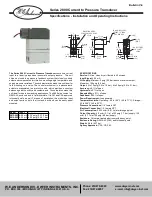
ENC-900 Operating Manual: Chapter 4 Configuration
19
The escape sequence will not
be accepted unless both the
ENC-900 and the terminal
are set to the same baud rate
The units should now be communicating. Remember, the parameters defined
by Factory Settings 1 and 2 will likely not be the most ideal for your
application, but will quickly allow you to test the units. A complete
summary of the settings defined by all four factory settings can be found in
Appendix D. Factory Default Settings.
Settings are not immediately stored in non-volatile memory, therefore, the
command &W is issued to store the current configuration into non-volatile
memory. Settings are retained even after powering down. All user
selectable parameters for the ENC-900 are described in detail in Sections 4.2
and 4.3:
4.1.1 Checking the Link
To check if the units are communicating, observe the LED indicators on the
development board which houses the Remote unit. If the link is good, up to
three RSSI LEDs on the Remote modem should be active along with the
RX/Sync LED, and if the link is absent (due to a fault at one end or another,
such as misconfiguration), the LED’s will be in either “scanning mode” or
inactive. See Section 2.2 for complete LED operation.
Characters typed at the Master terminal should appear at the Remote’s
terminal, and vice versa. Also, verify that the RX LED blinks as packets of
data are received at the Master modem. As data is sent from Remote to
Master, the RX indicator should blink on as correct packets of data are
received. At this point, the Master’s RSSI LED’s should become active. It
is recommended that if the ENC-900 will be deployed in the field where
large distances separate the units, the modems should be configured and
tested in close proximity (
e.g.
, in the same room) first to ensure a good link
can be established and settings are correct. This will facilitate
troubleshooting, should problems arise.
4.2 AT Commands
Several AT Commands are supported by the ENC-900. These commands
affect the operation of the modem in command mode and the transition
between data and command modes. More commands and S-Register settings
are discussed in Sections 4.3 and 4.4.
To make the command line more readable, you can insert as many spaces as
desired. The command line holds up to 16 characters, not including the AT
prefix. If you want to send more than one command line, wait for a response
before entering the AT prefix at the start of the next command line. To re-
execute the previous command, enter A/. The modem will execute the
previous command line.
When in Command Mode, the modem “autobauds”, meaning that it will
automatically adjust to the baud rate of the terminal. You may change the
terminal baud rate while in Command Mode without losing communication
with the modem.
For the AT command protocol, an escape sequence consists of three
consecutive escape codes preceded and followed by at least 1 second of
inactivity. Typically, the ‘+’ character is used as the escape code.
+++
preceded and followed by 1 second of inactivity
Summary of Contents for ENC-900
Page 9: ...ENC 900 Operating Manual Chapter 2 Electrical Physical 5 ...
Page 17: ...ENC 900 Operating Manual Chapter 2 Electrical Physical 13 ...
Page 44: ...40 ENC 900 Operating Manual Chapter 4 Configuration ...
Page 46: ...42 ENC 900 Operating Manual Appendix A Modem Command Summary ...
Page 48: ...44 ENC 900 Operating Manual Appendix B Factory Default Settings ...
Page 50: ...46 ENC 900 Operating Manual Appendix C Technical Specifications ...
Page 54: ...50 ENC 900 Operating Manual Appendix E Approved Antennas ...
















































